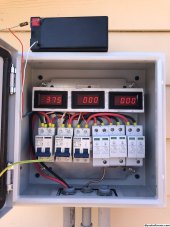Things I've ruled out:
1. Because the matching Negative breaker shows no signs of heat or issues, I think it's safe to rule out it was not an overload "surge" or sizing issue with wire or breaker. 8 gauge wire on a 20 amp load is oversized and should create no heat at that load.
2. Trip extinguish was not it, as the breaker was not tripped.
To me it's one of two things that caused this:
1. One possibility is, as many of you suggested, not a good wire connection on that particular breaker lug causing heat build up over time and eventually a melt down. As I've stated the wire is still in there and solid. Did it fuse during melt down, maybe....
2. Breaker was defective and did not make good internal contact to the terminal end that melted. There was internal arcing and that is ultimately where the circuit failed, but I can't say for sure the heat build up started there.
What I think I'll do.
1. I'm going to install Ferrule ends on the cables going into the breakers and torque the connections down good
2. I'm going to leave the cover off for now and monitor the terminal/breaker temps throughout the peak of the day. I have a spare matching 63 amp breaker, I'll use for now. These breakers are used as disconnects for PV, not over current protection, so oversized breaker should not be of concern. I'll report my findings.



